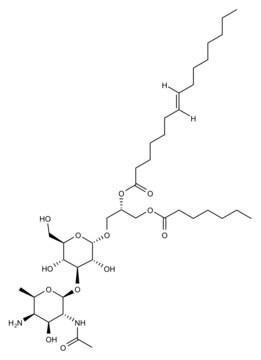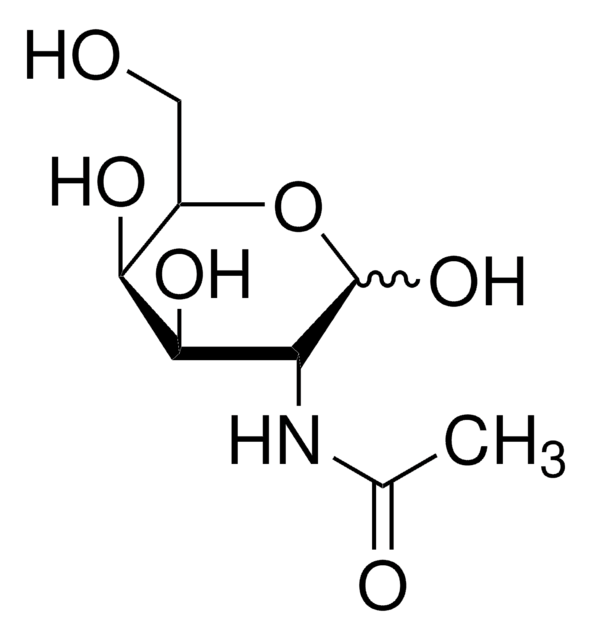Wszystkie zdjęcia(1)
Kluczowe dokumenty
77140
Peptidoglycan from Staphylococcus aureus
cell wall component
Synonim(y):
Peptidoglycan from S. aureus
Zaloguj sięWyświetlanie cen organizacyjnych i kontraktowych
About This Item
Polecane produkty
Poziom jakości
Formularz
lyophilized powder
rozpuszczalność
soluble, hazy to turbid, colorless to faintly yellow
temp. przechowywania
−20°C
Powiązane kategorie
Zastosowanie
Peptidoglycan from Staphylococcus aureus has been used:
- for the stimulation of lymphocytes: peptidoglycan activates the toll-like receptor 2 (TLR2), present in mammalian cells. It works as an antagonist of Poly (I:C)
- for g-type lysozyme stimulation by intraperitoneally inoculating it into sole specimens
- in phosphate buffer saline and injected into Labeo rohita fingerlings, to study its effect on nucleotide-binding oligomerization domain-2 (NOD-2) gene expression
Działania biochem./fizjol.
The cell wall of gram positive bacteria is largely made up of peptidoglycan. It is composed of polysaccharide chains interlinked by peptide bridges. This peptidoglycan gives a certain rigidity to the cell wall and gives the cell mechanical strength. It is a surface molecule which is known to stimulate immune reactions including cytokine production to fever.
Opakowanie
Bottomless glass bottle. Contents are inside inserted fused cone.
Inne uwagi
Major component of the cell wall in gram positive organisms. Consists of a glycan backbone with alternating β 1-4 linked residues of N-acetyl-D-glucosamine and muramic acid. The immunological activities of bacterial peptidoglycans; Peptidoglycan types of bacterial cell walls and their taxonomic implications; Antibody response to peptidoglycan during staphylococcal infections
Ta strona może zawierać tekst przetłumaczony maszynowo.
Kod klasy składowania
11 - Combustible Solids
Klasa zagrożenia wodnego (WGK)
WGK 3
Temperatura zapłonu (°F)
Not applicable
Temperatura zapłonu (°C)
Not applicable
Środki ochrony indywidualnej
Eyeshields, Gloves, type N95 (US)
Wybierz jedną z najnowszych wersji:
Masz już ten produkt?
Dokumenty związane z niedawno zakupionymi produktami zostały zamieszczone w Bibliotece dokumentów.
Klienci oglądali również te produkty
L J Wheat et al.
The Journal of infectious diseases, 147(1), 16-22 (1983-01-01)
Levels of antibodies to peptidoglycan were measured by solid-phase radioimmunoassay in 76 patients with Staphylococcus aureus infections and 44 patients with infections caused by other bacteria. Levels of IgM antibodies to peptidoglycan were elevated in 24% of the patients with
The immunological activities of bacterial peptidoglycans.
D E Stewart-Tull
Annual review of microbiology, 34, 311-340 (1980-01-01)
Genomic characterization, phylogeny and gene regulation of g-type lysozyme in sole (Solea senegalensis)
Ponce M, et al.
Fish & Shellfish Immunology, 31(6), 925-937 (2011)
Xue Kong et al.
Frontiers in physiology, 9, 1476-1476 (2018-11-09)
Vesicomyidae clams are common species living in cold seeps, which incorporates symbiotic bacteria into their body maintaining endosymbiosis relationship. As members of pattern recognition receptor (PRR) family, peptidoglycan recognition proteins (PGRPs) recognize pathogen associated molecular patterns and play an important
A peptidoglycan recognition protein in innate immunity conserved from insects to humans
Kang D, et al.
Proceedings of the National Academy of Sciences of the USA, 95(17), 10078-10082 (1998)
Produkty
Peptidoglycans
Nasz zespół naukowców ma doświadczenie we wszystkich obszarach badań, w tym w naukach przyrodniczych, materiałoznawstwie, syntezie chemicznej, chromatografii, analityce i wielu innych dziedzinach.
Skontaktuj się z zespołem ds. pomocy technicznej








